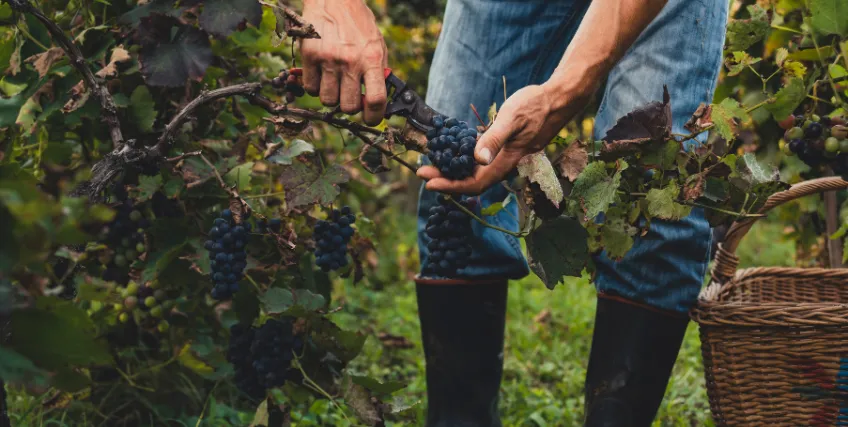Plant, Pour & Prosper:
Things to Know About Vineyard Finance
Looking for Business Financing?
Apply now for flexible business financing. Biz2Credit offers term loans, revenue-based financing, lines of credit, and commercial real estate loans to qualified businesses.
Set up a Biz2Credit account and apply for business financing.
According to World Population Review, the United States is one of the four countries that make more than half of all the wine in the world. In fact, US is also one of the top three countries that drink the most wine. Thus, vineyard finance has become non-negotiable for winegrowers, to buy equipment, plant more grapes and keep their business flowing. Many growers use winery loans and vineyard loans to pay for tractors, new vineyard land or better tools. Lenders also offer financing for vineyards, so that owners can handle large costs that come up each year. This kind of vineyard and winery financing helps vineyards in the U.S. grow, improve and prosper.
This page details the types of financing for vineyards, how they work and how vineyard owners can use them to grow their business. It also explains what lenders look for, the steps to apply and tips to improve loan approval.
What Is Vineyard Finance and Why It Matters?
In the U.S., vineyard finance refers to specialized funding for vineyard owners and wineries, including loans, leasing, and lines of credit, used to manage cash flow and buy important assets. These services help fund equipment, like tractors and harvesters, to the expansion of acreage and operational upgrades. This allows businesses to make long-term investments without disruptions. The U.S. wine market is expected to reach USD 157,277.5 billion by 2033 and grow at a CAGR of 8.8% in the coming year, according to Grand View Research.
Further, vineyard finance helps manage cash flow gaps and provides capital investment opportunities. A flexible line of credit or custom financing can help a vineyard owner make use of opportunities, such as acquiring new fields or taking advantage of supplier discounts.
Common Uses of Financing for Vineyards
Common uses of vineyard finance include buying land and vineyard equipment, funding working capital, and investing in storage facilities and tasting rooms. Financing options, such as term loans and commercial mortgages, help cover large capital expenditures and ongoing operational costs, allowing vineyards to grow and remain competitive. Below is a list of common uses of vineyard loans by winegrowers and related business owners:
Types of Financing for Vineyards
In the U.S., there are multiple options related to financing for vineyards, handing out several benefits, such as longer repayment terms or competitive rates for agribusiness. These funding solutions give owners flexibility, based on their budget and goals. Here's a list of common finance options for winegrowers and winery owners:
Term loans
A lump sum of cash for long-term, large-scale projects, like buying land, building facilities, or major upgrades.
SBA Loans (7(a) and 504)
Government backed loans that offer lower rates and long repayment time for qualified applicants. SBA 7(a) is used for equipment, land, repairs and working capital. SBA 504 is used for large projects like buying land or building new structures.
Business Lines of credit
A flexible, revolving credit line, from which borrowers can draw funds as needed and repay as they go. The interest has to be paid only on the borrowed amount.
Equipment Financing
Specific loans or leases to finance the purchase of costly equipment, such as tractors, sprayers, and harvesters, spreading over the cost into manageable payments.
Working Capital Loans
Short-term loans to cover day-to-day operating expenses and manage seasonal cash flow crunches.
Angel Investors/Venture Capitalists/Private Investors
Sell partial ownership in the business in exchange for capital. This doesn't require repayment, but the owner must share future profits and control to some extent.
Grants and Cost Share Programs
Money from USDA or state wine agencies that does not need repayment; used often for vineyard improvement or specialty crop projects.
US Farm Loan Programs for Vineyards
Vineyard owners can use many USDA Farm Service Agency (FSA) loan programs. These loans have lower rates, easier terms and help farms grow, recover from a setback or get started fresh. Here are few of the common options:
Operating Loans
These help farmers pay for things they need at the moment. They can be used for seeds, tools, equipment, livestock, fertiliser, repairs and even family living costs while the farm is getting stable.
Farm Ownership Loans
Help farmers buy a farm or expand an existing one. They can also pay for building new structures, improving old ones, or protecting soil and water.
Microloans
Small, simple loans for new or small farmers. They need less paperwork and are good for special crops or non traditional farms. Microloans can be used for small equipment, tools, supplies or small land needs.
Emergency Loans
These help farmers recover after natural disasters, such as droughts, floods or storms. They help replace losses and keep the farm running.
Tips to Qualify for Vineyard Loans
To be eligible for vineyard finance, applicants must prepare well beforehand. This includes providing a detailed business plan, accurate financial records, like the last three years of tax returns and bank statements, and a plan for managing seasonal cash flow. Lenders also typically require personal financial information, proof of assets, a down payment or even collateral, in some cases. Here's a list of typical requirements to qualify for vineyard loans:
- Personal Identification: Give a copy of gov ID to confirm identity.
- Business Plan: Show how the vineyard will earn money and handle slow seasons.
- Financial Records: Share past tax returns and bank statements to prove stability.
- Profit and Loss Statements: Provide latest income and expense summary.
- Balance Sheet: List what is owned and what is owed.
- Asset Verification: Show documents for extra assets like investments or savings.
- Down Payment: Be ready to pay part of the loan amount upfront.
Steps to Apply for Vineyard and Winery Financing
Applying for vineyard and winery financing is a structured process. It requires thorough preparation, a deep understanding of the industry's unique financial cycles, and accurate, transparent documentation. Here are a few common steps to take, when applying for vineyard finance:
Preparation and Documentation
- Develop a detailed business plan: A clear plan shows industry knowledge, financial projections and seasonal cash flow strategy.
- Organize personal finances: All personal financial records should be collected and ready.
- Check and improve credit score: A strong credit profile helps secure better loan terms.
- Detail the use of funds: A clear explanation of how the money will support growth, strengthens the application.
Finding and Vetting Lenders
- Explore financing options: Conventional banks, USDA programs and agribusiness lenders offer different benefits.
- Compare loan offers: Key factors include rates, terms, fees, flexibility and lender experience in the wine sector.
Application and Approval Process
- Submit application: All documents should be organised and included with the loan request.
- Demonstrate collateral: Land, equipment or inventory can help secure stronger terms.
- Build a lender relationship: Clear communication and expert guidance support a smoother approval process.
Vineyard Finance: Tips to Improve Loan Approval Chances
To improve vineyard finance approval chances, applicants must focus on strengthening their financial profile by improving credit scores, lowering existing debt, and preparing a detailed business plan. The latter must include financial projections and revenue streams. Borrowers also should ideally gather all necessary financial documents, such as bank statements and tax returns, and ensure cash flow can cover debt repayments. Here's a typical checklist to improve loan approval chances:
Financial health and credit
- Improve credit score: Timely bill payments help build a stronger score.
- Reduce existing debt: Clearing small loans and card balances lowers overall debt.
- Showcase strong cash flow: Stable income records show the ability to manage payments in slow months.
Business and loan application
- Create a strong business plan: A clear plan explains goals, costs and how the loan supports growth.
- Gather all financial documents: Tax returns and financial statements should be organised and available.
- Demonstrate assets: Property, tools or inventory can serve as valuable collateral.
- Have a repayment strategy: A defined plan for repayment builds lender confidence.
Lender-specific strategies
- Shop around for lenders: Comparing offers helps identify the most suitable terms.
- Seek professional advice: Guidance from agricultural finance experts can improve the application.
- Consider a co-signer or secured loan: Additional support can strengthen overall eligibility.
Finishing Notes: A Smooth Close on Vineyard Finance
A strong vineyard finance plan helps every vineyard, winery and wine business manage costs, improve operations and support long term growth. Many financing solutions, from agricultural loans to farm credit and small business loan options, are built to meet the unique needs of winemaking and vineyard financial planning. With the right advisory services, flexible repayment schedules and support for refinancing or upgrades, vineyard owners across regions can choose a loan that fits their goals.
Trusted by Thousands of Small Business Owners in America.**
Simply because we get what you go through to build a business you believe in.
**Disclaimer: All stories are real, as told by real business owners. Customers do not receive monetary compensation for telling their stories.
From One Entrepreneur to Another: We Get You
We understand what's behind building a business you believe in.
All stories are real, as told by real business owners. Customers do not receive monetary compensation for telling their stories.



Articles on Loans for Vineyards
A Complete Guide to Vineyard Loans and Financing Options
You probably dreamed of running a vineyard and becoming a business owner long before you planted your first grapevine. The rows of vines...
Popular Financing Options for Starting Your Own Vineyard
Starting a vineyard may sound like a dream — whether inspired by movies like Under the Tuscan Sun or Sideways, or a trip to Napa...
Vineyard Loans vs. Agricultural Loans: What’s the Difference
Being a vineyard business owner in the U.S., you know how much work goes into your vineyard. These include long days, changing seasons...
FAQs About Vineyard Finance
1. Can new vineyard owners qualify for vineyard finance?
It is possible for new vineyard owners to qualify for vineyard finance, but it generally requires more comprehensive documentation. Startups typically need a solid business plan, clear financial forecasts, and potentially a co-signer or collateral. Programs backed by the USDA, may be more approachable to new owners.
2. What to consider when comparing vineyard finance offers?
When comparing vineyard loans, consider the annual percentage rate (APR), loan term, monthly payments, and whether the lender understands the wine industry's seasonality. Also, check for early repayment penalties and upfront fees.
3. What types of collateral or down-payment might lenders require for vineyard and winery financing?
Many lenders offering vineyard and winery financing expect a significant down-payment or equity share, especially for land or property loans. Some real-estate vineyard loans may require around a lump sum down payment or solid collateral, such as land, equipment or existing business assets. Choosing a lender experienced with vineyards, can help borrowers understand the specific collateral or down payment needs.
4. What credit score is needed to qualify for vineyard loans?
A strong credit score makes it simpler to qualify for vineyard loans because lenders want to see steady repayment history and responsible money management. Some lenders may still consider applicants with weaker credit, if the vineyard has solid cash flow, a strong business plan or valuable collateral. Programs backed by the government can also be more flexible for vineyard and winery financing.
5. Can vineyard finance be used to buy equipment and upgrade vineyard operations?
Vineyard finance can be used to buy tools and machines that help growers work quicker and improve grape and wine quality. Many lenders allow vineyard loans to cover tractors, sprayers, harvesters and irrigation upgrades because equipment has a big effect on production. Growing investment in modern vineyard equipment shows that lenders understand how important these upgrades are for better yields.
Frequent searches leading to this page
Term Loans are made by Itria Ventures LLC or Cross River Bank, Member FDIC. This is not a deposit product. California residents: Itria Ventures LLC is licensed by the Department of Financial Protection and Innovation. Loans are made or arranged pursuant to California Financing Law License # 60DBO-35839



